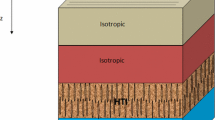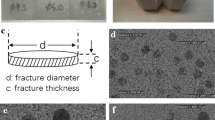Abstract
Fractures are pervasive features within the Earth’s crust and have a significant influence on the multi-physical response of the subsurface. The presence of coherent fracture sets often leads to observable seismic scattering enabling seismic techniques to remotely locate and characterise fracture systems. In this study, we confirm the general scale-dependence of seismic scattering and provide new results specific to shear-wave propagation. We do this by generating full waveform synthetics using finite-difference wave simulation within an isotropic background model containing explicit fractures. By considering a suite of fracture models having variable fracture density and fracture size, we examine the widening effect of wavelets due to scattering within a fractured medium by using several different approaches, such as root-mean-square envelope analysis, shear-wave polarisation distortion, differential attenuation analysis and peak frequency shifting. The analysis allows us to assess the scattering behavior of parametrised models in which the propagation direction is either normal or parallel to the fracture surfaces. The quantitative measures show strong observable deviations for fractures size on the order of or greater than the dominant seismic wavelength within the Mie and geometric scattering regime for both propagation normal and parallel to fracture strike. The results suggest that strong scattering is symptomatic of fractures having size on the same order of the probing seismic wave.
Similar content being viewed by others
References
Aki K. and Richards P.G., 1980. Quantitative Seismology. W.H. Freeman and Co., San Francisco, CA.
Baird A.F., Kendall J.-M. and Angus D.A., 2013. Frequency-dependent seismic anisotropy due to fractures: Fluid flow versus scattering. Geophysics, 78, WA111–WA122.
Barnes A.E., 1993. Instantaneous spectral bandwidth and dominant frequency with applications to seismic reflection data. Geophysics, 58, 419–428.
Barton N., 2007. Rock Quality, Seismic Velocity, Attenuation and Anisotropy. CRC Press, London U.K.
Båth B., 1974. Spectral Analysis in Geophysics. Elsevier, Amsterdam, The Netherlands.
Carter A.J. and Kendall J.M., 2006. Attenuation anisotropy and the relative frequency content of split shear waves. Geophys. J. Int., 165, 865–874.
Chapman M., Maultzsch S., Liu E. and Li X.-Y., 2003. The effect of fluid saturation in an anisotropic multi-scale equant porosity model. J. Appl. Geophys., 54, 191–202.
Crampin S., 1981. A review of wave motion in anisotropic and cracked elastic media. Wave Motion, 3, 343–391.
Dvorkin J., Mavko G. and Nur A., 1995. Squirt flow in fully saturated rocks. Geophysics, 60, 97–107.
Fukushima Y., Nishizawa O., Sato H. and Ohtake M., 2003. Laboratory study on scattering characteristics of shear waves in rock samples. Bull. Seismol. Soc. Amer., 93, 253–263.
Hall S.A. and Kendall J.-M., 2000. Constraining the interpretation of AVOA for fracture characterisation. In: Ikelle L. and Gangi A. (Eds), Anisotropy 2000: Fractures, Converted Waves, and Case Studies. Society of Exploration Geophysicists, Tulsa, OK, 107–144.
Hildyard M.W., 2001. Wave Interaction with Underground Openings in Fractured Rock. Ph.D. Thesis. University of Liverpool, Liverpool, U.K.
Hildyard M.W., 2007. Manuel Rocha Medal Recipient- Wave interaction with underground openings in fractured rock. Rock Mech. Rock Eng., 40, 531–561.
Hudson J.A., 1981. Wave speeds and attenuation of elastic-waves in material containing cracks. Geophys. J. R. Astron. Soc., 64, 133–150.
Liu E. and Martinez A., 2012. Seismic Fracture Characterization: Concepts and Practical Applications. EAGE Publications, Houten, The Netherlands.
Liu E.R., Hudson J.A. and Pointer T., 2000. Equivalent medium representation of fractured rock. J. Geophys. Res., 105, 2981–3000.
Lubbe R., Sothcott J., Worthington M. H. and McCann C., 2008. Laboratory estimates of normal and shear fracture compliance. Geophys. Prospect., 56, 239–247.
Margerin L., 2011. Seismic waves, scattering. In: Gupta H. (Ed.), Encyclopedia of Solid Earth Geophysics. Springer, Dordrecht, The Netherlands, 1210–1223.
Maultzsch S., 2005. Analysis of Frequency-Dependent Anisotropy in VSP Data. Ph.D. Thesis. University of Edinburgh, Edinburgh, U.K.
Maultzsch S., Chapman M., Liu E. and Li X.Y., 2003. Modelling frequency-dependent seismic anisotropy in fluid-saturated rock with aligned fractures: implication of fracture size estimation from anisotropic measurements. Geophys. Prospect., 51, 381–392.
Müller T.M. and Shapiro S.A., 2001. Most probable seismic pulses in single realizations of two-and three-dimensional random media. Geophys. J. Int., 144, 83–95.
Narr W., Schechter D.W. and Thompson L.B., 2006. Naturally Fractured Reservoir Characterization. Society of Petroleum Engineers, Richardson, TX.
Neerhoff F. and Van der Hijden J., 1984. Diffraction of elastic waves by a sub-surface crack (antiplane motion). J. Sound Vibr., 93, 523–536.
Nishimura T., 1996. Horizontal layered structure with heterogeneity beneath continents and island arcs from particle orbits of long-period P waves. Geophys. J. Int., 127, 773–782.
Nishizawa O., Pearson C. and Albright J., 1983. Properties of seismic wave scattering around water injection well at fenton hill hot dry rock geothermal site. Geophys. Res. Lett., 10, 101–104.
O’Connell R.J. and Budiansky B., 1974. Seismic velocities in dry and saturated cracked solids. J. Geophys. Res., 79, 5412–5426.
Pyrak-Nolte L.J. and Nolte D.D., 1992. Frequency dependence of fracture stiffness. Geophys. Res. Lett., 19, 325–328.
Quan Y. and Harris J.M., 1997. Seismic attenuation tomography using the frequency shift method. Geophysics, 62, 895–905.
Sato H., 1989. Broadening of seismogram envelopes in the randomly inhomogeneous lithosphere based on the parabolic approximation: Southeastern Honshu, Japan. J. Geophys. Res., 94, 17735–17747.
Sato H. and Fehler M.C., 1998. Seismic Wave Propagation and Scattering in the Heterogeneous Earth. Springer-Verlag, New York.
Sayers C. and Kachanov M., 1991. A simple technique for finding effective elastic constants of cracked solids for arbitrary crack orientation statistics. Int. J. Solids Struct., 27, 671–680.
Shearer P.M. and Earle P.S., 2004. The global short-period wave field modelled with a monte carlo seismic phonon method. Geophys. J. Int., 158, 1103–1117.
Shen F. and Toksöz M.N., 2000. Scattering characteristics in heterogeneously fractured reservoirs from waveform estimation. Geophysical Journal International, 140, 251–266.
Van Der Hijden, J. and Neerhoff, F. (1984). Scattering of elastic waves by a plane crack of finite width. J. Appl. Mech., 51, 646–651.
Verdon J.P. and Wüstefeld A., 2013. Measurement of the normal/tangential fracture compliance ratio (ZN/ZT) during hydraulic fracture stimulation using S-wave splitting data. Geophys. Prospect., 61, 461–475.
Willis M., Pearce F., Burns D., Byun J. and Minsley B., 2004. Reservoir fracture orientation and density from reflected and scattered seismic energy. 66th EAGE Conference and Exhibition 2014. EAGE Publications, EAGE, Houten, The Netherlands.
Willis M.E., Burns D.R., Rao R., Minsley B., Toksöz M.N. and Vetri L., 2006. Spatial orientation and distribution of reservoir fractures from scattered seismic energy. Geophysics, 71, O43–O51.
Worthington M. and Lubbe R., 2007. The scaling of fracture compliance. Geol. Soc. London Spec. Publ., 270, 73–82.
Yousef B.M. and Angus D.A., 2016. When do fractured media become seismically anisotropic? some implications on quantifying fracture properties. Earth Planet. Sci. Lett., 444, 150–159.
Zhang Y., Chi S., Willis M.E., Burns D. and Nafi T.M., 2005. Comparison of discrete fracture and effective media representation of fractures on azimuthal avo. SEG Technical Program Expanded Abstracts 2005, 305–307, DOI: 10.1190/1.2144328.
Zhang Y., Chi S., Willis M.E., Toksöz M.N. and Burns D.R., 2006. Orientation Estimation for Multiple Large Fractures by Scattering Energy. Technical Report. Earth Resources Laboratory, Massachusetts Institute of Technology, Cambridge, MA.
Author information
Authors and Affiliations
Corresponding author
Rights and permissions
About this article
Cite this article
Yousef, B.M., Angus, D.A. Analysis of fracture induced scattering of microseismic shear-waves. Stud Geophys Geod 61, 728–753 (2017). https://doi.org/10.1007/s11200-016-0384-9
Received:
Revised:
Accepted:
Published:
Issue Date:
DOI: https://doi.org/10.1007/s11200-016-0384-9




